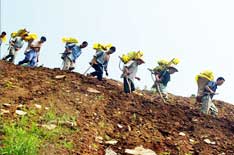Upon its expected completion in 2009, this structure will be the world’s largest hydroelectric dam. It will generate 18.2 million kilowatts of electricity, equivalent to the power of 18 nuclear power plants or 40 million tons of coal. The idea for a dam that would harness the power and control the flooding of the world’s third longest river, the Yangtze, was first proposed in 1919 by Sun Yat-sen, father of the Chinese Republic. Plans for such a dam resurfaced several times until 1978, when economic reforms and a burgeoning industrial base necessitated more energy production, and in 1979 the State Council approved the project. Construction began in 1994. Yet since 1998, the closing of many state-operated enterprises has actually left China with a surplus of energy. Dam critics say the surplus highlights the overblown nature of a project that could have been built smaller, with less impact on the region’s people and environment. The government feels the scale of the dam is necessary to tap into the nation’s vast potential for energy consumption.
The Economics
Officially, the dam is on track to stay within the limits of its $24 billion budget, although unofficial estimates of the cost run as high as $75 billion. The economic goal of the dam is to generate an enormous source of cheap electricity and make the region accessible to 10,000-ton ocean-going vessels laden with goods for trade, rendering China’s interior provinces more appealing to foreign investors. The dam, which will have more than 770 billion cubic feet of flood-control storage in its reservoir, is also meant to prevent costly flood damage. In 1998, for instance, flooding in eastern China killed more than 2,000 people and left another 14 million homeless at a cost of $5.4 billion. Another major plus: the dam’s supply of hydroelectric energy could encourage China to lessen its dependence on polluting coal-burning power. Yet the gorges themselves — three steep canyons at the base of the Wu Shan Mountains — are among China’s most spectacular scenery; filling them up with water, many argue, will undermine the region’s thriving tourist industry.

Workers transport relics from a Song Dynasty government mansion in Badong County to higher ground. The area will be submerged once the Three Gorges Dam reservoir reaches capacity. Photo: Reuters |
Human Displacement
To make way for the 350-mile-long reservoir, more than half a million people have already been relocated. Most of them are farmers, and there have been complaints about the poor quality of the land they have received as compensation. Human-rights advocates have also reported that the Chinese government has not offered displaced residents adequate living accommodations, new job opportunities, or additional job training. By 2009, as many as 1.2 million people are expected to lose their homes to the dam’s reservoir.
Environmental Concerns
Perhaps the biggest concern about the dam’s environmental impact surrounds industrial sites and waste facilities that will not be secured or decontaminated before being submerged by the reservoir. A lack of treatment plants in the area that will surround the new shoreline could cause waste runoff to seep into the reservoir and river, environmentalists say. Critics also argue that the dam may upset the delicate balance of the river’s current eco-system, threatening a number of endangered species, as well as flood valuable agricultural land with its reservoirs. Still, these worries show no sign of delaying construction. According to a statement released by China’s U.S. Embassy, more than a dozen waste water treatment plants are planned for the cities of Chongqing, Fuling, and Wanxian, all located in the reservoir area.
Cultural Heritage Impact
The area that will be submerged after the dam’s completion includes ancient temples and burial grounds. A total of 1,300 archeological sites, many of which have never been explored, will be lost in the reservoir. Dam defenders argue that historically significant material will be moved to higher ground before the gorges are flooded, and efforts are underway to rescue ancient structures from the area.
- Previous: Introduction
- Next: Turkey



